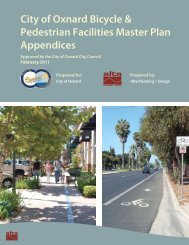View File - Development Services - City of Oxnard
View File - Development Services - City of Oxnard
View File - Development Services - City of Oxnard
Create successful ePaper yourself
Turn your PDF publications into a flip-book with our unique Google optimized e-Paper software.
WATER RESOURCES TECHNICAL REPORThydrogeologic studies on the <strong>Oxnard</strong> Plain. The observation well would be drilled to adepth <strong>of</strong> approximately 1,200 feet.Extracted Water Facilities. Pilot ASR injection well storage facilities would consist <strong>of</strong> a20,000-gallon tank or open basin for periodic maintenance during well operation. To controlclogging during normal operation, water would be pumped periodically to the tank or openstorage basin to allow sediments to settle. Water stored in the tank would be disposed <strong>of</strong>onsite or discharged <strong>of</strong>fsite in accordance with NPDES permit regulations. If the open basinwere implemented, water would percolate into the ground surface. Extracted water facilitieswould occur within the 1-acre pilot ASR injection well site. Recovered groundwaterextracted from the pilot ASR injection well would be transferred to the PTP via the recycledwater delivery system during pilot ASR program injection-extraction cycles.Potable Water ASRThe approach to implementing potable water ASR would include retr<strong>of</strong>itting four existingwells (Well Nos. 20, 21, 22, and 23) and constructing three to four new wells at the <strong>City</strong>Water Yard. The potable water ASR wells would extract (and at times inject) water from(and at times into) the UAS and LAS. Existing Well Nos. 20 and 21 are completed in theLAS, and Well Nos. 22 and 23 are completed in the UAS. These four existing wells have acapacity <strong>of</strong> approximately 3,000 gpm. The new potable water ASR wells would becompleted in the UAS and would each have a capacity <strong>of</strong> approximately 1,000 to 3,000 gpm.The locations <strong>of</strong> the existing wells to be retr<strong>of</strong>itted (at the <strong>City</strong> Water Yard) are shown inFigure 4-2. The new potable water ASR wells would be located on the perimeter <strong>of</strong> <strong>City</strong>Water Yard property as shown in Figure 4-5. Three wells are proposed to be sited along theperimeter <strong>of</strong> the site. If a fourth well is determined to be needed, it would also be locatedalong the perimeter <strong>of</strong> the site.Facilities associated with the potable water ASR include:• Conveyance facilities to convey potable water to the potable ASR wells within the<strong>City</strong> Water Yard• ASR well and injection-extraction pumping equipmentApproximately 800 feet <strong>of</strong> 24-inch miscellaneous yard piping would be required todistribute potable water throughout the <strong>City</strong> Water Yard. ASR well injection and extractionequipment would be similar to that described above for pilot ASR (Section 4.3.4.1).4.3.5 Regional DesalterAs discussed in Section 4.2 GREAT Program Overview, the delivery <strong>of</strong> recycled water forirrigation would generate groundwater storage credits through (1) displacement pumping<strong>of</strong> groundwater on the <strong>Oxnard</strong> Plain and (2) groundwater injection conducted as part <strong>of</strong>aquifer storage and recovery. The groundwater pumping allocations not used byagricultural interests and groundwater storage credits gained through aquifer storage andrecovery represent a new local water source that the <strong>City</strong> could supply to its customers tomeet potable demand. The unused groundwater pumping allocation and groundwaterstorage credits could be redeemed through the Fox Canyon Groundwater ManagementAgency, the agency that manages the region’s groundwater supply. The groundwater notW112003002SCO LW1458.DOC/ 033390002 58
















